More notes from the talks i heard at De l’objet de laboratoire au sujet social (From Laboratory Object to Social Subject), a week of lectures, screenings and workshops which took place a few days ago at the Ecole d’Art d’Aix en Provence.
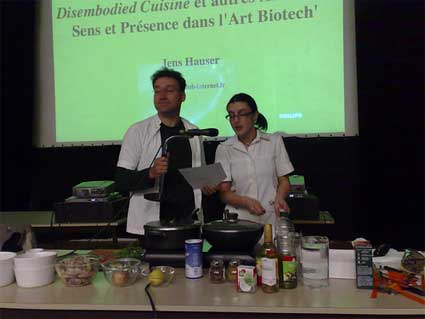 Jens Hauser and France Cadet cooking frogs and lentils for us (Image B-E-Art)
Jens Hauser and France Cadet cooking frogs and lentils for us (Image B-E-Art)
Previously: Eduardo Kac’s presentation in Aix en Provence.
In 2003, International curator Jens Hauser curated the first exhibition in Europe of artists who use biotechnology as a medium for expression. More recently, he curated Still, Living in Perth, Australia and is currently working on Sk-Interfaces, a conference (on 08 – 09 February 2008) and exhibition which will open in January 31 at FACT, in Liverpool.
sk-interfaces will explore the idea of skin as a technological interface. The show will feature the work of artists who use biology as a material for art and new commissions from artists including Orlan and Zbigniew Oksiuta. The event will turn FACT’s exhibition spaces into a hybrid lab / art space where visitors will experience an engaging, critical and thought-provoking approach to how current technologies are changing our perceptions of the body and bridging the gap between science and art.
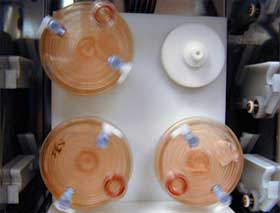 Growing the semi living steak in a bioreactor for Disembodied Cuisine
Growing the semi living steak in a bioreactor for Disembodied Cuisine
Jens’ was a two part presentation. In the morning, he discussed the meaning of “bioart” (which is also sometimes called “wet art”, “moist art”, “biotech art”, etc.), how artists are exploring the frontier between man and animal and creating cultural discussions around biotech-related issues, the relationship between presence and representation (referring to Hans Ulrich Gumbrecht‘essay The Production of Presence: What Meaning Cannot Convey), mimesis and real, dimension of the sense and dimension of the senses.
I’m not going to write down everything he said during his presentations but will just highlight a few key elements (well… at least those that got my attention):
Something in common that bioart has with performance art is that they both leave behind them only video documentation and some material remains. In the case of Disembodied Cuisine, the remains were pictures, videos and more surprisingly the remnants of engineered frog steaks that were so hard to chew that most participants spat the bits out.
Interestingly, the artistic project has concrete retroactive effects. By bringing the concept of tissue-engineered ersatz meat into the public domain, the artists have made it difficult for commercial firms to patent and make a profit out of “tissue engineered meat”.
These victimless steaks refer to Winston Churchill’s famous quote: Fifty years hence we shall escape the absurdity of growing a whole chicken in order to eat the breast or wing by growing these parts separately under a suitable medium.
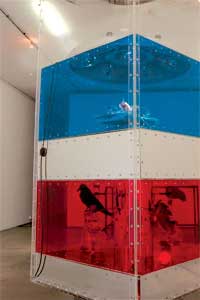 Image 7×7 sf
Image 7×7 sf
Hauser introduced us to TC&AP’s latest work, NoArk, which is on view until January 6 as part of the Biotechnique exhibition at the Yerba Buena Center for the Arts. The research project explores the taxonomical crisis induced by life forms created through biotechnology.
Developments in life sciences have created new ways for beings to come into the world, and new categories of existence that are challenging the order of the world. This requires us- humans to rethink our understandings and our relationships with our own identity/body, other animals, as well as the concept of life itself. The growing number of ‘labmade’ life forms requires special attention. In pharmacological factories, research universities, and other technologically driven institutions there already exists a mass of disassociated living cells and tissues in the thousands of tons. These fragments do not fall under current biological or cultural classifications.
NoArk is a Noah’s Ark for the biotech age, an experimental vessel designed to maintain and grow a mass of living cells and tissues that originated from different organisms. This vessel serves as a surrogate body for a collection of living fragments which are presented alongside technologically preserved specimens of organisms. At the top are McCoy cells (what makes the work all the more thought-provoking is that the McCoy cell line originated from a human and is now classified as a mouse cell line), at the bottom are taxidermied animals. As opposed to classical methodologies of collection, categorization and display that are seen in Natural History museums, contemporary biological research is focused upon manipulation and hybridisation, and rarely takes a public form. NoArk uses cellular stock taken from tissue banks, laboratories, museums and other collections. It contains a chimerical ‘blob’ made out of modified living fragments of different organisms, which are living together in a techno-scientific body. Like the cabinets of curiosities that preceded the Natural History museum’s refined taxonomy NoArk’s collection of unclassifiable sub-organisms acts as a symbolic precursor to a new way of approaching a made nature.
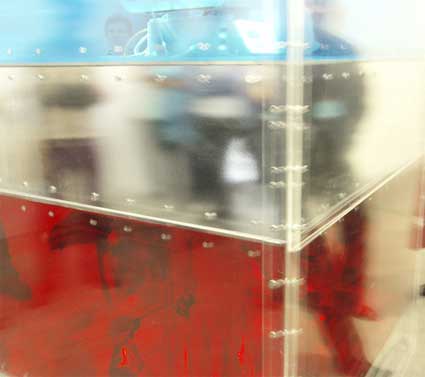 Image uploaded by Lisbeth Klastrup on flickr
Image uploaded by Lisbeth Klastrup on flickr
The questions that TC&AP aims to raise with NoArk range from “How do taxonomical systems based on traditional classification accommodate life forms created by humans?” to “What could be the artistic and technological strategies for maintaining and exhibiting living collections of sub-organisms for long periods of time? NoArk presents ecology of parts as an attempt to observe the living world through a post-anthropocentric system. More in Visual Culture and Bioscience.
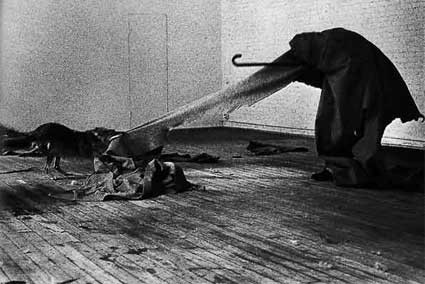 Beuys, I Like America and America Likes Me, 1974
Beuys, I Like America and America Likes Me, 1974
Another book mentioned by Jens Hauser in his talk is Postmodern Animal, by Steve Baker which looks at how animal imagery has been used in modern and contemporary art, and in postmodern philosophy and literature, to suggest ideas about identity and creativity and raise questions about our relationship to animals. Examples of artistic works include Helena – The Goldfish blender, by Marco Evaristti, Carsten Holler and Rosemarie Trockel’s Ein Haus fur Schweine und Menschen (A house for pigs and people), Joseph Beuys’s three days co-habitation with a coyote, Dennis Oppenheimer, Dali, etc. But these works comment on animals as they already exist, not on animals as they might exist one day. Works coming from artists such as TC&AP, Joe Davis, Art oriente Objet, Eduardo Kac, explore the mechanisms of life itself.
That’s the moment when Hauser put things straight about biotech art. Going back to 1993, the year when ars electronica titled its festival Artificial Life – Genetic Art but presented mainly artworks dealing with softwares, synthetic imaging, digital organisms, etc. It was more about creating life on a software and hardware level.
Ten years later, in 2003, Hauser curated L’Art Biotech at the Lieu Unique in Nantes. The exhibition engaged directly with the organic matter in a tangible and critical way.
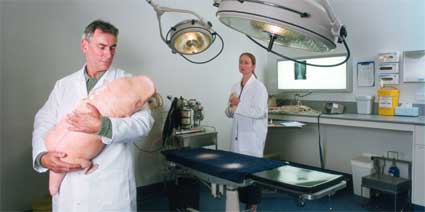 Patricia Piccinici: Laboratory Procedures, 2001
Patricia Piccinici: Laboratory Procedures, 2001
Confusion on the terminology: bioart works should not be confused with works that deal with the theme of biotechnology: photoshoped images, sculptures of chimera, computer programmes, etc. Yet those works often feed traditional art museums when they need to take a stand on the emerging topic of biotechnology. They are easy to show and keep in a gallery. Besides, they allow museums to keep their hands clean.
Jens Hauser ended his talk with a video of Eduardo Kac’s, The Eighth Day, an installation which investigates the new ecology of fluorescent creatures that is evolving worldwide.
The Eighth Day is not meant to point the finger and say “transgenic is bad”, it’s more complex than that, the work is meant to raise awareness, to highlights the fact that whether we like it or not we are now surrounded by transgenic life. The work communicates to a larger audience the true complexity of the phenomenon, the visual impact of the artwork enables a better apprehension. The GFP becomes a means to communicate the message, it acts as a vector of social commentary.
Another issue is that a misconception of what is nature circulates, the world as we know it is a constant recreation of life, think of the wholphin (a hybrid, born from a mating of dolphin and a whale Pseudorca), the liger (a hybrid cross between a male lion and a female tiger), the zorse or zebrula (the offspring of a zebra stallion and a horse mare), etc. These genetic examples occurred spontaneously.
More books: L’Art Biotech, curated by Jens Hauser and its recently published Italian version.
Related: Oron Catts´talk at ars electronica; Bioart – Taxonomy of an Etymological Monster (original text.)
